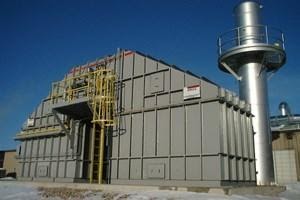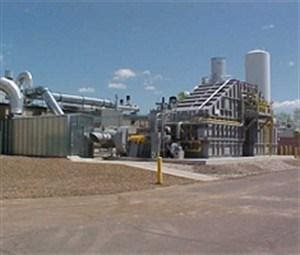Plastic Components Painting
Comments Off on Plastic Components PaintingThe Challenge
A plastic injection molding company in Wisconsin is known as a world-class leader in the industry for their secondary decorating and assembly capabilities. One of their eleven facilities not only perform plastic injection molding but also provides the organization with decorating capabilities such as painting, laser etching, laser marking, pad printing and assembly of automotive, telecommunication and consumer products.
Over the years and through the 1990’s the operation ran successfully with a minor source air pollution control operation permit. This permit consists of very specific requirements to meet the Environmental Protection Agencies (EPA) LACT (Latest Available Control Technology) regulation. These included restricted limits on volatile organic compounds (VOC) per gallon of paint, catalyst, thinner and cleaning solvent as purchased. This limited the types of paints and colors they could offer customers but given the customer needs and production volume at the time, this was a manageable situation.
As the business grew, requests by customers for more exotic forms of paint and colors increased and they realized the need to increase their paint capabilities to compete. In December 2000 they applied for two new permits with The Department of Natural Resources (DNR), one for an air pollution construction permit to install a new state of the art robotic paint line system and the other for the ability to paint small metal parts. This permit modification changed the facility from a minor source of less than 100 tons per year of volatile organic compound emissions to a major source with the potential to emit over 225 total tons.
With the new permit, they not only had to meet the LACT requirements for the painting of plastic parts but now also needed to meet the MACT (Maximum Achievable Control Technology) requirements for the painting of small metal parts. The MACT requirements added a higher level of restrictions to VOC’s per gallon of paint as applied to metal parts. These restrictions were applicable and once again manageable.
Although the new permit allowed them to meet additional painting volume capacity requirements, they observed continued demand by their customers for paints that could not be used under the air permit. Additionally, with the acceptance into the ISO 14001:1996 standards, they realized the need to significantly reduce their VOC emissions.
The Solution
The only way to meet the customer demands and reduce emissions was to evaluate various forms of pollution control technologies. Anguil’s group of engineering experts convened to explore the various control technologies currently available on the market. Consideration was given to equipment/concepts such as:
- Catalytic Oxidizers
- Thermal Oxidizers
- Regenerative Thermal/Catalytic Oxidizers
- Emissions Concentrator Coupled with a Regenerative Thermal Oxidizer
- Microwave VOC Reduction Technologies
- Biofilter VOC Reduction Technologies
The company began to work very closely with the sales and engineering team at Anguil and the DNR to establish the best available control technologies to meet the pollution control requirements. With some simple calculations, Anguil was able to show how a Regenerative Thermal Oxidizer (RTO) would be the most cost-effective control technology for their current and future process demands.
The Result
After thoroughly evaluating several suppliers the company decided to go back to the Department of Natural Resources and request a new air pollution control construction permit to install a Anguil Model 400 / 40,000 SCFM (62,800 NM3/hr) Regenerative Thermal Oxidizer (RTO) for their existing paint operations.
The oxidizer would achieve destruction through the process of high temperature thermal oxidation, converting the VOCs to carbon dioxide and water vapor while reusing released thermal energy to reduce operating costs. Process gases with VOC contaminants enter the oxidizer through an inlet manifold. Dual disk poppet valves direct this gas into energy recovery chambers where the process gas is progressively preheated by the ceramic media beds as they move toward the combustion chamber.
The VOCs are oxidized in the combustion chamber, releasing thermal energy in the structured ceramic media beds that are in the outlet flow direction from the combustion chamber. These outlet beds are heated, and the gas is cooled so that the outlet gas temperature is only slightly higher than the process inlet temperature. Fast acting vertical poppet valves alternate the airflow direction into the ceramic beds to maximize energy recovery within the oxidizer. The VOC oxidation and high energy recovery within these oxidizers reduces the auxiliary fuel requirement and saves operating cost. For example, at 95% thermal energy recovery, the outlet temperature may be only 70`F (40`C) higher than the inlet process gas temperature with an RTO. The oxidizer can reach self-sustaining operation with no auxiliary fuel usage at low VOC concentrations.
Programmable Logic Controllers (PLCs) control the automatic operation of the oxidizer from startup to shut down, so minimal operator interface is required. These controls also provide for remote telemetry to enable the system’s operation to be viewed and altered via remote connections to reduce maintenance costs.
Later that fall the permit was accepted by the DNR for an air pollution control construction permit to install an Anguil Regenerative Thermal Oxidizer. Anguil Environmental Systems was able to complete the design, fabrication, delivery, installation and startup of the RTO so it could go on line early the next year.
After startup of the new RTO, a stack test measured 99% destruction rate efficiency for volatile organic compound (VOC) emissions at 100% capture. This equated to a net reduction of 58 tons of VOC emissions in the first 6 months of operation.
The benefits of installing the RTO included the ability to offer customers a large variety of paints and colors to meet their more unique paint finish requests. Also, the RTO allowed the manufacturer to use previously restricted thinners and paints to better process their products with fewer rejects. This allowed the business to grow and succeed in an increasingly competitive environment and meet the new demands from customers while significantly reducing the amount of volatile organic compounds released into the environment.
Paint Booth Over Spray
Comments Off on Paint Booth Over Spray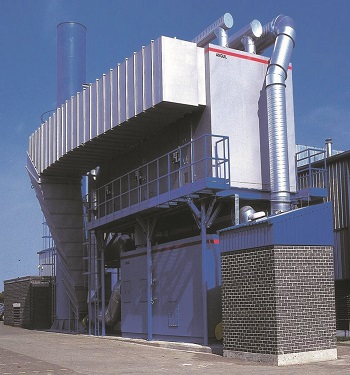 The Challenge
The Challenge
A major automotive component supplier needed to control the emissions from its paint spray process. The plant emissions had characteristics common to many paint spray plants: high air flow, low volatile organic compound (VOC) concentration and particulate. The company needed an emission control solution that had low operating costs and that could also fit in their limited space. System reliability was also a major design consideration; since the company is a synchronized delivery partner to the automobile industry, plant downtime or process delays result in expensive fines.
The Solution
After an extensive technical evaluation of the proposed technologies and equipment manufacturers, the customer chose Anguil Environmental Systems to provide a turnkey solution for the VOC and particulate emissions. Anguil recommended an Emissions Concentrator coupled with a Thermal Oxidizer System to effectively process the 120,000 SCFM (190,000 Nm3/hr) of plant exhaust.
The Result
The cost of an emission control system is predominantly based on the volume flow rate of air that needs to be treated. Emissions from paint spray applications have historically been expensive to control because the process requires large volumes of air to maintain the quality of the painted products and to ensure acceptable indoor air quality. Anguil’s Emissions Concentrator technology makes VOC emission control cost-effective because it greatly reduces the air volume that needs to be processed by the oxidizer.
In this case, the Emissions Concentrator reduces the flow rate of process air that needs to be treated by a factor of 15, a major consideration in the capital cost of the system. The high-volume airstream from the water wash paint booths and the curing ovens is passed through the rotor concentrator wheel, where the VOCs are adsorbed in the emissions concentrator rotor, purifying the high-volume airstream. This high-volume air is then exhausted to atmosphere. The concentrator wheel rotates continuously, transporting adsorbed VOCs into a desorption section where they are desorbed into a low volume heated airstream. After being desorbed from the wheel, the air volume has been reduced from 120,000 SCFM (190,000 Nm3/hr) to about 8,000 SCFM (12,700 Nm3/hr) and the VOC concentration of the air stream is increased to about 4,500 ppmv. This low volume, high VOC-laden air is then processed by the oxidizer. By isolating and treating only the contaminated air, Anguil can provide a system with operating costs far lower than alternative emission control systems.
Innovative technologies like the Emissions Concentrator are just part of the solution Anguil provides. Anguil believes a complete solution involves careful analysis of the emission-producing process and engineering that is focused on the customer’s specific application. As always, Anguil worked closely with this customer to identify and solve their key concerns.
System reliability was the first concern for this customer. The plant is a Tier One supplier to the automotive industry and must meet very stringent delivery deadline requirements. Failure to meet a delivery schedule can result in fines of up to $30,000 a minute. One of the reasons Anguil recommended the Emissions Concentrator system is its highly reliable performance. Anguil took extra steps to integrate the system into the existing process and engineered the system with safety controls and advanced Programmable Logic Controls (PLC) for trouble-free operation.
The next design consideration was the tight space restriction. Due to several plant expansions, the facility had reached its legal minimum of parking spaces and nearby residential development meant the company could not purchase additional land. Local zoning restrictions also required the planned equipment to meet strict noise limits. Therefore, the emission control system had to be designed with the smallest possible footprint and with low noise generation. Anguil’s customer-specific engineering accommodated the unique space restrictions with a major advance in Emissions Concentrator/Oxidizer system design. A vertical arrangement that greatly reduces the unit’s space requirements gave the system a footprint that is 70% smaller than the space requirements for the Regenerative Thermal Oxidizer (RTO) proposed by several competitors. Additionally, the design incorporated several sound attenuation features to satisfy the low-level noise requirements.
Another major concern was controlling the high level of particulate in the paint spray exhaust. Particulate control was necessary to protect the concentrator rotor and to satisfy the low particulate emission limit. Anguil supplied a highly efficient filtration system designed for simple, low-cost filter replacements that can be easily changed out during scheduled maintenance.
Anguil’s solution included a complete on-time turnkey installation. The system was seamlessly integrated into the existing process and is exceeding regulatory requirements. Anguil’s combination of proven application-specific engineering and technologically advanced products has led to yet another satisfied customer.
Paint Mixing
Comments Off on Paint Mixing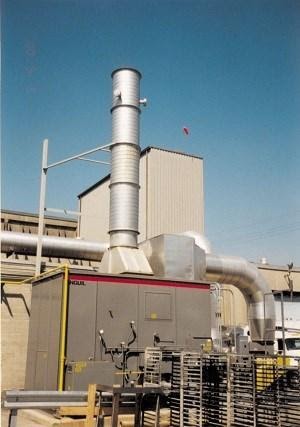 The Challenge
The Challenge
A company involved in the automotive aftermarket had a paint batch mixing and filling operation that used primers and fillers. They were faced with installing air pollution control equipment to handle the volatile organic compounds (VOCs) emitted by the solvents used in their processes. An independent consultant had determined that total exhaust volume from the facility was 28,000 SCFM (44,940 Nm3/hr) of air and as is often the case with painting operations this air contained relatively low concentrations of solvent vapors. This combination of high exhaust volume and low vapor concentration posed an operating cost problem. In addition, powdered material dumped into the batch mixers generated dust, causing potential OSHA violations and hazards to the operators.
The Solution
After thorough technical evaluation, Anguil Environmental Systems, Inc. was selected and contracted to solve the VOC problem and satisfy EPA requirements.
Anguil analyzed the operation and focused on the composition of the solvents and the high air volume. Of the solvents used, a small portion was methylene chloride. Chlorinated compounds are a potential poison to most catalytic systems and the company’s consultant recommended a thermal incinerator. Anguil recognized that a less expensive alternative to a thermal unit would be an Anguil Chloro-Cat capable of processing the chlorinated compounds. However, Anguil recommended evaluation of alternate compounds to replace the chlorinated organics. Upon investigation, the company chemist determined that all the chlorinated compounds could be replaced with regular organic solvents.
The high air volume was then addressed. One of Anguil’s strengths is our knowledge in capture hooding and air flow reduction techniques. The 28,000 SCFM (44,159 Nm3/hr) of exhaust was originally recommended based on the assumption that all thirteen (13) batch mixing devices could potentially be at their peak mixing and vapor loading capacity simultaneously. Interviewing the facility manager, it was determined that not all thirteen mixers were ever loaded simultaneously.
With this information, Anguil developed and designed an air reduction system after mapping the fugitive VOC’s with a portable FID (Flame Ionizing Detector). This research allowed engineers to determine the areas of high VOC concentration and subsequently design the innovative capture system that drastically reduced the amount of treated air.
The Result
The company had been using floor sweeps as part of their capture system that were up to ten (10) feet away from the mixing devices. The mixing containers had covers that were poor fitting and extremely heavy. The distance between the floor sweeps and the mixing devices was the primary cause of floating dust and escaping vapors. The solution included replacing the floor sweeps and mixing tank covers with a close capture hooding system. Anguil designed a series of aluminum custom fabricated mixing covers with integral flexible duct connectors to draw the vapors and dust directly from the mixers. The added benefit of the close capture hooding was the decrease in air volume necessary to capture the vapors from the VOC source.
Anguil determined that all of the VOC’s from the mixing room could be adequately captured with 9,000 SCFM (14,194 Nm3/hr) of air and that future plans for expansion would not take the exhaust air volume above 12,000 SCFM (18,925 Nm3/hr). Rather than focusing on costly outside make-up air to replace this 9,000 SCFM (14,194 Nm3/hr) of exhaust, Anguil supplied close capture pick-up hoods in the mixing room immediately adjacent to the room containing the fill devices. This air was then transferred or “cascaded” into the adjacent mixing room, creating makeup air. The VOC concentration of this makeup air was well below the Threshold Limit Values (TLVs) but the state regulatory authorities determined that these VOC’s were fugitives and should be destroyed. The air supply was introduced on the far side of the mixing room which helped sweep the vapors across the 120 by 60-foot room towards the pick-up points.
Outside of the building, an Anguil 12,000 SCFM (19,260 Nm3/hr) catalytic oxidizer was supplied and installed on a concrete pad. Prior to entering the catalytic oxidizer, the entire airstream was fed through a two-chamber dust collector to prevent the particulate and dust from masking the catalyst or blocking the oxidizer’s plate type heat exchanger. A precious metal platinum catalyst was supplied to destroy the hexane and toluene organics. Adequate catalyst was supplied to process 9,000 SCFM (14,194 Nm3/hr) and as the facility capacity increased, more catalyst would be added. Due to the well-designed air reduction strategy, Anguil saved the customer tens of thousands of dollars on their pollution control system while achieving compliance.
Natural Gas Production
Comments Off on Natural Gas Production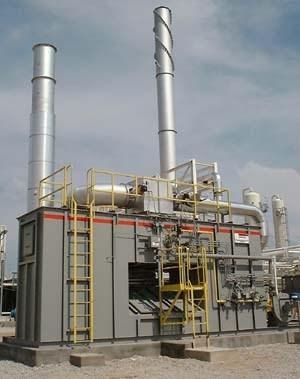 The Challenge
The Challenge
The largest U.S.-based independent oil and gas producer and one of the largest independent processors of natural gas and natural gas liquids in North America was in search of new technologies to maintain the pollution control efficiency at their natural gas treatment facility.
In typical gas plants, the wellhead natural gas needs to be treated to remove water, CO2, any sulfur compounds and heavy hydrocarbons before it is sent to the pipeline. The acid gases formed by CO2 and H2S are normally removed by amine adsorption. The amine must then be stripped of these acid gases in order to be reused. The amine stripper off gas (tail gas) needs to be treated before discharge to atmosphere to remove residual hydrocarbons and meet EPA regulations.
The Solution
Gas and oil plants have historically used direct-fired thermal oxidizers with no heat recovery for tail gas treatment. The existing thermal oxidizer at this facility was using a considerable amount of auxiliary fuel to maintain temperatures of 1,500°F, ensuring all the organics were combusted but costing them a significant amount of money in operating costs. Dedicated to finding a less expensive means of regulatory compliance, the oil and gas producer challenged several air pollution control manufacturers to provide a system that was not only effective, but also energy efficient.
When Anguil was approached to address the air pollution control needs at this facility, careful measures were taken to assure the proper equipment selection.
The Result
After much consideration, Anguil offered their Model 75 (7,500 SCFM, 12,037.5 Nm3/hr) Regenerative Thermal Oxidizer (RTO) with heat recovery for efficient and effective operation. Anguil was selected because of their unique approach toward air pollution control and energy conservation.
With the Anguil two-bed RTO, the contaminated process gas is pre-heated as it passes through beds of ceramic media located in the energy recovery chambers. The process gas moves from the pre-heat chamber toward the combustion chamber, where the Volatile Organic Compounds (VOCs) are oxidized, releasing energy into the second energy recovery chamber before going to atmosphere. A diverter valve switches the process gas direction so both energy recovery beds are fully utilized, thereby reducing any auxiliary fuel requirement. This system is designed for heat recovery of 85% and is self-sustaining, requiring little auxiliary fuel use. This energy-efficient design offers significantly lower operating costs in comparison to other emission treatment methods.
The RTO is designed to prevent corrosion by the acid gases and to handle the high organic loading with low oxygen levels. The gas at this facility is “sweet” and does not contain any H2S but precautions were taken to prevent carbonic acid attack due to the CO2. In addition, Anguil provided a Class 1, Division 2, Group D control package. Heated, fresh air was also introduced into the system, providing supplemental oxygen without condensing moisture in the process stream. Anguil’s application specific engineering was an important factor in the success of this project.
The Anguil RTO is achieving 99% DRE (Destruction Rate Efficiency) and is saving the customer more than $500,000 per year in natural gas costs. Anguil’s equipment, detailed system design, installation and startup has exceeded the customer’s expectations of efficiency and affordability.
Amine Tail Gas Treatment
Comments Off on Amine Tail Gas Treatment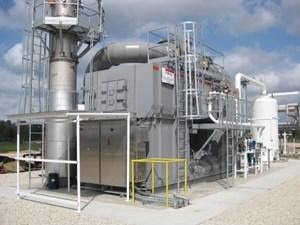 The Challenge
The Challenge
The discovery of new shale formations throughout the world and the development of new drilling technologies have increased natural gas production and prompted government agencies to instigate tighter air-pollution control regulations on processing operations. Unfortunately, meeting environmental regulations is not a profit-generating endeavor. Simply put, the time and money spent on protecting air, water and land does not help midstream companies produce more natural gas to ensure the nation’s energy security. As a result, saving money while meeting or exceeding regulations should be on every midstream company’s wish list.
Much like other industries, oil and gas producers are often required by the Environmental Protection Agency(EPA) to obtain a Title V permit, the objective of which is to prevent untreated air pollutants from entering the atmosphere. In addition to their harmful effects on plants and trees, these pollutants, known as volatile organic compounds (VOCs) and hazardous air pollutants (HAPs) are known to cause respiratory ailments, heart conditions, birth defects, nervous system damage and cancer in humans.
Under the Clean Air Act, most companies with the potential to release more than 10 tons of a single VOC or HAP during a one-year period, or 25 tons of multiple compounds, must install either a pollution-control device or the maximum achievable control technology (MACT). Many of the pollution control devices currently used to abate these emissions also emit significant amounts of carbon dioxide (CO2) and nitrous oxides (NOX). With mandatory greenhouse gas (GHG) reporting on the horizon, processors could soon be paying for the carbon emissions generated by some of these pollution control systems, adding to the capital and operating costs associated with regulatory compliance.
MIDSTREAM’S ABATEMENT HISTORY
A number of production techniques and processes used by midstream companies are, or soon will be, regulated as emission sources. From stationary combustion engines to amine systems, the industry is facing some fairly strict legislation.
One area of great concern is amine tail-gas treatment. Amine systems are a very common and critical component used by natural gas-processing facilities to remove acid gases, CO2 and hydrogen sulfide (H2S) from the wellhead. This is accomplished by running the gas through a column with amine liquid flowing in the opposite direction, stripping acids from natural gas and absorbing them into the liquid. The natural gas is then sent for processing while the amine is sent to be regenerated. The regeneration process removes the acid gases from the amine solution, allowing it to be reused, but the process creates tail gas. This tail gas, and the means for treating it, offer the latest opportunity for the implementation of new technologies and increased profits.
Thermal and catalytic oxidizers are technologies commonly used on a wide variety of applications where VOC, HAP and odor abatement is required. They destroy harmful emissions through the process of high-temperature combustion. Midstream companies have historically used flares, vapor combustors, direct-fired thermal oxidizers (TOs) or recuperative systems for emission destruction. Applications where these devices are applied range from amine tail-gas treatment, nitrogen rejection units and liquefied natural gas (LNG) processes. The temperature in these systems is maintained somewhere between 1,400°F and 1,800°F so that hydrocarbons are converted to CO2 and water vapor, while the H2S is converted to sulfur dioxides (SO2 and SO3).
When designed properly, these older technologies are fairly dependable, but their effectiveness and efficiency can spark a heated debate. In the case of flares, water is often injected into the device to reduce visible black smoke. This drastically reduces the destruction efficiency-and the EPA is taking note. While TOs and vapor combustors can achieve destruction efficiencies around 99%, they share a common negative aspect with flares: They have a high fuel consumption rate.
Large amounts of fossil fuels are required to bring the air toxins up to proper destruction temperature. Rather than use the heat generated from combustion to preheat incoming pollutants, the energy is simply released into the atmosphere, along with CO as GHGs. Chart A demonstrates just how significant the carbon emissions can be from the various technologies.
The Solution
ENTER THE RTO
All too often, production facilities take the “no news is good news” approach to their air-pollution control equipment when they really should be chasing the benefits of a “company stays green and saves green” approach. A proven, more fuel-efficient abatement technology, called the regenerative thermal oxidizer (RTO), is now being applied to tail-gas treatment where it was once thought impossible.
What differentiates it from other technologies is its ability to use the proper mix of temperature, residence time (or dwell time), turbulence and oxygen to convert pollutants into carbon dioxide and water vapor, while reusing the thermal energy generated to reduce operating costs. In some cases, emission destruction can occur without any additional natural gas or other supplemental fuel.
VOC and HAP laden process gas is routed into the inlet manifold of the oxidizer, flow control or poppet valves, which then directs this gas along with fresh air for combustion into energy-recovery chambers where it is preheated. The process gas and contaminants are progressively heated in the ceramic media beds as they move toward the combustion chamber.
Once oxidized in the combustion chamber, the hot purified acid gas releases thermal energy as it passes through the media bed in the outlet flow direction. The outlet bed is heated and the gas is cooled so that the outlet gas temperature is only slightly higher than the process inlet temperature. Poppet valves alternate the airflow direction into the media beds to maximize energy recovery within the oxidizer.
Thermal energy recovery (TER) within an RTO can reach 97%, reducing, and in some cases eliminating, the auxiliary fuel requirement. Some gas plants have reported over $500,000 in operating cost savings annually. With destruction capability over 99%, the RTO is not only an efficient alternative for this application, but also very effective. However, careful consideration must be given to the design and materials of construction to avoid corrosion, equipment failures, non-compliance and safety issues.
CASE IN POINT
The midstream division of a large, multinational energy corporation was operating several amine systems around the country with tail-gas treatment. A TO at one of these facilities in the western U. S. had numerous operational problems and extremely high operating costs.
The company asked Anguil Environmental Systems Inc., an oxidizer and air-pollution control systems provider, to evaluate various replacement options. The process data provided showed a tail-gas flow rate of about 15,000 pounds per hour (lbs/hr) or about 2,500 standard cubic feet per minute (SCFM) (4012.5 Nm3/hr), a calorific value of 6 Btu/SCF and 25 parts per million by volume (ppmv) of H2S. After evaluating numerous oxidizer technologies, including TOs and thermal recuperative oxidizers, Anguil determined that the best solution would be an RTO.
Having designed oxidizers for similar corrosive applications, the engineers at Anguil recommended that the RTO be built with special materials of construction and design considerations to combat the presence of both carbonic and sulfuric acid.
Carbonic acid is caused by high CO2 levels combined with a saturated process stream. Sulfuric acid is created when H2S is oxidized and the resulting SO3 combines with water vapor present in the RTO exhaust gas. The amine process exhaust at this midstream operation was inert, or lacking oxygen; therefore, fresh air was required for oxidation.
Heat released from combustion of these hydrocarbons can be very high, so fresh air is also added to keep the system from an over-temperature condition. To eliminate condensation of water vapor of the tail gas inside the RTO, this ambient air is preheated to protect metal surfaces from the inorganic acids condensing.
A unique system utilizing excess heat from the combustion chamber to provide the necessary heat was deployed on this system, further reducing operating costs. The preheat component eliminates the need for additional equipment (gas-fired heater, steam coil) and further minimizes auxiliary fuel consumption. The next step in the corrosion-protection strategy is to implement various stainless-steel alloys on critical components and a corrosion-resistant coating on the inside of the energy-recovery chambers and combustion chamber. The type of stainless steel chosen depends on the presence and concentration of H2S.
The critical components are chosen based on their function within the RTO and their location. These components see exhaust temperatures of up to 600°F, above the limit of corrosion-resistant coatings. The energy recovery chambers and combustion chamber are internally insulated with soft ceramic refractory insulation, limiting the shell temperature (and the maximum temperature to which the coating will be exposed) to 200°F, well below the safe limit of the coating. With the combination of extremely high TER, and the tail-gas calorific value of 6 Btu/SCF, this RTO requires no auxiliary fuel to achieve 99% hydrocarbon and H2S destruction efficiency.
By comparison, a TO or flare designed for the same process gas would consume more than $100 per hour of auxiliary fuel, resulting in an annual fuel cost of more than $750,000. Also, the reduced natural gas consumption results in an additional 2,600 lbs/hr of GHG emissions compared to the RTO.
The Result
PROCESSING PROFIT
With the industrial price of natural gas at $6 per thousand cubic feet, and a one-to-one correlation between a cubic foot of natural gas and a cubic foot of CO2 emissions, certified carbon credits could go for about $10 to $30 per metric ton or 1,000 kilograms. This is about 20,000 cubic feet of CO2 on a one-to-one cubic foot to cubic foot basis, then 20,000 cubic feet of natural gas produces one metric ton of CO2.
The credit might be worth $1 per thousand cubic feet of natural gas, or about 15% of the cost, meaning a reduction in natural gas consumption would not only save operating costs but it could, in theory, produce income, assuming a credit can be certified and traded.
Organic Particulate Filtration
Comments Off on Organic Particulate Filtration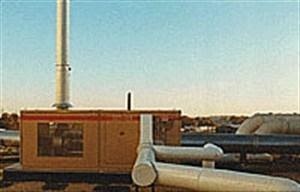 The Challenge
The Challenge
A food products company that mixes various types of waxes and other components to make the base for chewing gums was faced with the issue of cleaning up a slightly odorous, visible emission being exhausted from two of their process lines. The components of the emission were hot particles of chewing gum and some volatile organic compounds (VOC’s). The particles would quickly clog a conventional filter system or electrostatic precipitator, neither of which could control the odor off the process line. In addition to the emission problem, the condensation of the exhaust stream was damaging the roof of the facility.
The Solution
After thorough technical evaluation, the Self-Cleaning Ceramic Filter (SCCF) was recommended as the ideal solution for processing the exhaust and Anguil Environmental Systems was selected to solve the visual, odor and VOC problem.
The Result
In order to demonstrate to the client that this was a viable solution, Anguil utilized their portable self-cleaning ceramic filter test unit before any purchase decisions were made. During the test, the process lines were run through the ceramic filter in two modes, hot and cold.
First, the system was run in the hot mode with a gas burner firing continuously at 400º-500ºF heating up the process air. The once visible plume disappeared as it passed through the ceramic filter and catalyst module. Second, the ceramic filter was used without heat, and again, the visible plume disappeared as it passed through the ceramic filter and catalyst module. Twenty-four hours of production were run across the ceramic filter without heat and the visible emission was acceptable from a customer and environmental regulation standpoint. However, when utilizing a cold process stream, particulate matter accumulated on the ceramic filter which had to be periodically cleaned by firing the burner. When the cleaning cycle began after the two shifts, a dense white plume was emitted for 90 seconds while the filter element was burned clean. The customer, a food products company, felt that this emission level was not acceptable so they decided the continuous hot running ceramic filter would better fit their needs. It should be noted that for certain operations with visible emissions, the pulse cleaning mode may be acceptable. Many local authorities allow companies to discharge up to five minutes per hour without control.
After the customer determined that the ceramic filter would solve their problems, Anguil proceeded to manufacture and install a 1,000 SCFM (1,577 Nm3/Hr) ceramic filter unit. The unit was used to process the exhaust from two process lines. One of the more significant benefits to the company was Anguil’s ability to reduce the air volume from the processes. Initially, the two gum-based mixers each had a 3,000 SCFM (4,731 Nm3/Hr) high volume, low static pressure fan that was exhausting to atmosphere. Tight covers on the mixers minimized the escape of odor into the mixing room. With the close capture hoods it was possible to reduce the air volume from 6,000 SCFM (9,462 Nm3/Hr) exhaust to 1,000 SCFM (1,577 Nm3/Hr) exhaust from the two process lines. The net air volume reduction of 82% reduced both the capital cost and the operating cost of the system.
In order to guarantee continuous production in the event of a burner failure, Anguil installed a bypass equipped with conventional roughing filters. The exhaust fan was equipped with an inlet vane control to vary the air volume if only one process line was being used. The control panel was outfitted with a user-friendly PLC first out detection system. The entire ceramic filter system was mounted in a light-weight enclosure to allow for roof mounting without significant structural modifications to the building. Growth capacity was accommodated in the gas burner and the fan section, allowing for the addition of future operations. Anguil’s system engineering provided their client with a solution to their compliance needs at reduced air volume and reduced cost.
Meat Processing Odor Control
Comments Off on Meat Processing Odor Control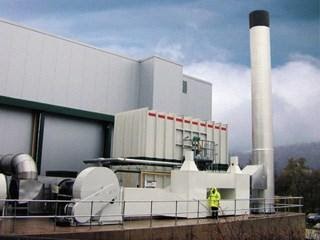 The Challenge
The Challenge
For its first two years of production, a food manufacturer based in South Wales, England, focused its production on potatoes. Neighborhood residents voiced no complaints about odors during this time period. However, as new production lines (including barbequed meats and curried chicken) were added, the complaints began, and it became clear that odor abatement equipment was needed to resolve the issue.
Onsite meetings were held to discuss the issue, concerned citizens and the local environmental health officer attended to discuss the best way to handle the situation. The company employs a large percentage of the local residents, and was concerned about maintaining good community relationships, while at the same time it was in need of a building expansion to introduce a new line of curried chicken products. Planning approval became contingent upon the installation of an odor abatement system to control the new and existing odors.
The Solution
The two-year old factory had been designed to incorporate emission control equipment, and management was committed to installing the most effective technology available. After a thorough technical evaluation, Anguil Environmental Systems, Inc. was selected and contracted to address the odor emission problem and satisfy the building expansion requirements.
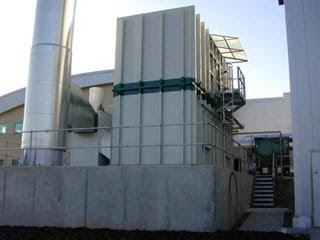 The Result
The Result
Although several odor control technologies were discussed — including masking sprays, wet scrubbing, bio-filtration, carbon absorption and catalytic and thermal oxidation — the Regenerative Thermal Oxidizer (RTO) was the only technology that could guarantee the elimination of 99% of the odorous compounds.
Since future production may produce different odors, it was necessary that the installed technology have the ability to treat a wide range of odorous compounds to a high level of removal/destruction – guaranteed. Although, the guarantee of nearly complete elimination of the odors was the primary concern, capital and running costs were also of utmost importance. The RTO was selected due to its low operating costs and the fact that no waste is produced as a byproduct of its functioning.
Following the installation of the RTO, the results were dramatic, and as promised nearly all of the odors have been eliminated. Due to its well-designed odor control strategy, Anguil resolved the odor emission problem, thereby resolving potential community relations/environmental issues, and meeting its requirements for obtaining planning approval for future expansions.
Bean Roasting
Comments Off on Bean Roasting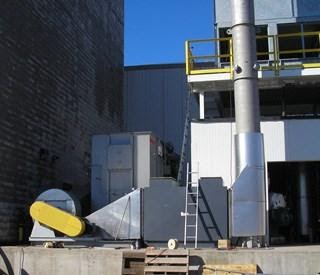 The Challenge
The Challenge
After purchasing a new Barth roaster for their East coast processing facility, a nationally known chocolate roaster company knew their emissions and odors would need to be addressed with the increase in production.
The Solution
Emissions and odors from the bean roasting process have traditionally been treated with an afterburner which simply burns the roaster exhaust with natural gas or other fuel types. This is an effective means of air pollution control but not very economical or energy-efficient. Rising fuels costs and the sustainability concerns prompted this company to find a more energy-efficient, cost-effective means of emission destruction.
Recognizing the need for a better solution within the industry, Anguil developed a dependable system that not only accounts for the unique needs of this application but also achieves environmental compliance at a fraction of the operating cost. Expected savings for a four bag roaster can be seen in the illustration below.
| Air Flow Rate | Fuel Cost / Hr | Savings Per Hour | |
| Afterburner | RTO | ||
| 2,500 SCFM (4,012.5 Nm3/hr) | $ 41.30 | $ 4.50 | $ 36.80 |
| 5,000 SCFM (8,025 Nm3/hr) | $ 81.14 | $ 6.71 | $ 74.43 |
| 7,500 SCFM (12,037.5 Nm3/hr) | $ 120.96 | $ 8.91 | $ 112.05 |
| 10,000 SCFM (16,050 Nm3/hr) | $ 160.80 | $ 11.11 | $ 149.69 |
Anguil recommended an 8,000 SCFM (12,840 Nm3/hr) Regenerative Thermal Oxidizer (RTO) to handle the Barth roaster, nip grinder and alkalizer at this facility.
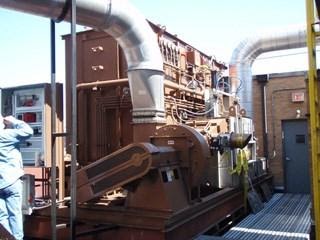 The Result
The Result
With the two-bed RTO, contaminated process gas is preheated as it passes through beds of ceramic media located in the energy recovery chambers. The process gas moves from the pre-heated chamber toward the combustion chamber, where the Volatile Organic Compounds (VOCs) are oxidized, releasing energy into the second energy recovery chamber before going to atmosphere. A diverter valve switches the process gas direction so both energy recovery beds are fully utilized, providing 95% thermal efficiency thereby reducing auxiliary fuel requirements. Under normal operating conditions the unit is self-sustaining, requiring no fuel use to achieve destruction. This energy-efficient design offers significantly lower operating costs in comparison to other emission treatment methods common bean roasting facilities.
Water vapor was a major concern during the design phase of this project and therefore provisions were taken to handle the high moisture airstream coming from the roaster. Not only is water a bi-product of bean roasting but it is also added for flavor and sterilization purposes, if precautions were not taken it could have caused system components to seize during freezing weather, accelerated corrosion of carbon steel parts or even oxidizer shutdowns during high production times. Anguil engineers recommended a knock out drum with removal pump just upstream of the RTO. Modifications were also made to the fresh air damper to introduce less water vapor and portions of the ductwork were insulated to prevent freezing.
Special consideration was given to the RTO ceramic media to account for any particulate in the airstream, ensuring proper operation. The oxidizer also has a bake-out feature which works much like the self-cleaning feature on a stove. Organic particulate is regularly burned out during a high temperature cycle, this ensures that the media does not plug, reduces pressure drop and lowers electrical consumption.
In addition to the emission and odor control equipment, Anguil provided a 7,000 SCFM (11,235 Nm3/hr) Plate Heat Exchanger and corresponding duct work. This sends approximately 1.5 BTU/hr of waste heat from the RTO exhaust stack to a make-up air unit on the roof, saving the company over $80,000 a year in plant heating costs during winter months. On similar applications, Anguil has returned waste heat back to the roasters which further reduces natural gas consumption and operating costs.
The company has purchased two similar systems from Anguil for facilities in other regions of the United States. The projects have resulted in environmental compliance, lower operating costs and fewer greenhouse gas emissions for the bean roasting company at all three plants.
Stainless Steel RTOs for Ethanol Emissions and Odors
Comments Off on Stainless Steel RTOs for Ethanol Emissions and Odors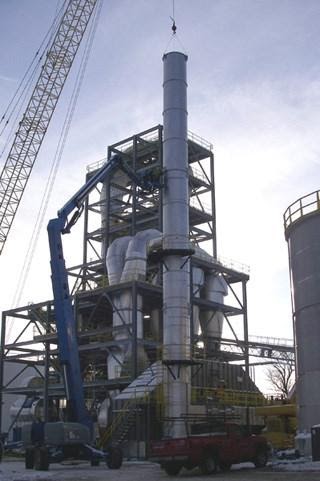 The Challenge
The Challenge
A 42 million gallon expansion at an ethanol production plant in the Midwest was certain to put the dry mill out of compliance for emissions such as Hazardous Air Pollutants (HAPs), Volatile Organic Compounds (VOCs), carbon monoxide (CO), nitrogen oxides (NOx), and particulate matter (PM). In general, ethanol production facilities in the United States are permitted to operate under a ‘minor source’ status as long as the total tonnage of key pollutants are below the 100 tons (named sources) or 250 tons (non-named sources) per year limit. However operating restrictions, penalties and fines, as well as community pressures are forcing many plants to strive for the lowest possible emission levels, enabling future capacity expansions.
The Solution
Anguil was awarded a multi-million dollar contract to assist the ethanol plant in meeting Environmental Protection Agency (EPA) regulatory requirements.
The Result
Known for their low operating cost and high destruction rate efficiency, the Anguil Regenerative Thermal Oxidizer (RTO) was selected as the best available control technology for the application. The pollution control device consists of two side-by-side Anguil RTOs handling a process volumetric flow of 120,000 SCFM (Standard Cubic Feet per Minute) (192,600 Nm3/hr). The system will achieve greater than 99% destruction rate efficiency for air pollutants and odorous emissions with 95% thermal energy recovery, ensuring low fuel usage. Portions of the equipment are constructed of 304-stainless steel to protect against corrosion from the ethanol process stream. The project scope consists of equipment design, manufacturing, installation supervision, process integration and start-up.
While several options and suppliers were considered, Anguil was awarded the contract after the Midwest producer evaluated system reliability, capital costs, destruction rate efficiency and operating cost estimates.
Keeping Ethanol Production Green
Comments Off on Keeping Ethanol Production Green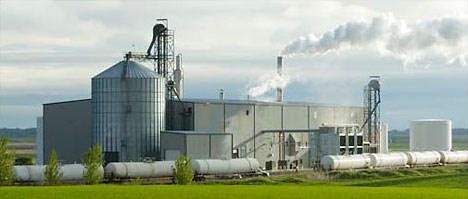 The Challenge
The Challenge
In an effort to reduce the world’s dependence on fossil fuels, there has been a major push towards alternatives. Ethanol has been at the forefront of this movement because it reduces greenhouse gas emissions from automobiles and its production has a positive net energy balance. The homegrown fuel also reduces the need for imported oil from sometimes unfriendly and unreliable supplier nations.
Ethanol is produced by fermenting and distilling starch, creating a 200-proof alcohol suitable for combustion in a vehicle. When processing corn, only 70 percent of the kernel is made into ethanol; the remaining fats, proteins, fiber, oils and minerals are referred to as distiller’s grain (DG). If a production plant is not very proximate to dairy operations or other significant livestock feeding needs, it will have to dry the DG in order to prevent spoilage during transport to more distant regional markets. Operating restrictions, penalties and fines, as well as community pressures, are forcing many plants to strive for the lowest possible emission levels from their dryers, enabling future capacity expansions.
Since air permits are granted on a facility-wide basis, when developing, designing and permitting ethanol production facilities, selecting the most appropriate process equipment as well as air pollution control equipment is critical. Some unique DG dryer designs are steam-heated or compressed air-based, but the vast majority of installed dryers are heated with natural gas. Regardless of the dryer type, volatile organic compounds (VOCs), odors and aerosols are emitted from the drying activity. By far the most commonly installed technology for this critical emissions source is some form of efficient thermal oxidation. Most of the major ethanol design firms incorporate thermal oxidation of this exhaust stream into their plant designs, and most state air permitting agencies require it.
 The Solution
The Solution
Process configurations & air permit implications
Selecting a dryer technology and its corresponding pollution control equipment often is the underlying decision for determining air permitting major source status. Prevention of significant deterioration (PSD) thresholds are now 250 tons per year (tpy) per pollutant facility-wide, since the EPA changed its interpretation of PSD rules for ethanol plants, in 72 FR 24060, on May 1, 2007.
In some non-corn-belt areas of the country where ethanol plants are now being proposed, such as those in ozone non-attainment areas or transport regions, major source thresholds are as low as 50 or even 25 tpy of VOCs to trigger non-attainment New Source Review (NNSR) permitting. When combustion emissions from boilers, emergency generators, fire water pump engines and load-out flares are added to those from the dryer and thermal oxidizer, one can envision why these decisions are critical.
NNSR permitting involves determining and installing the lowest achievable emissions rate (LAER), control technology, obtaining emissions offsets, and analysis of alternatives for the entire development project. PSD permitting involves dispersion modeling, best-available control technology (BACT) determination and commitment, and other impact analyses. Both NNSR and PSD permitting involve additional expense and longer permitting timelines, neither of which finds fondness with ethanol developers. Efficient, properly tuned thermal oxidizers are generally considered to meet BACT and LAER requirements, but there is surprisingly little history in the EPA’s RACT/BACT/LAER Clearinghouse database[1], since most ethanol developers to date have sought to avoid NNSR and PSD permitting by maintaining emissions below the threshold levels.
Abatement equipment selection
Some ethanol facilities in the upper Midwest were originally constructed without thermal oxidizers. However, odor complaints and EPA consent orders forced the installation of oxidizers, and hence some form of thermal oxidation is now a part of any new ethanol plant design involving a dryer. Certain plants with solid fuel boilers (often major sources) may vent the dryer exhaust into the boiler for thermal destruction. Others may recover some energy from direct-fired thermal oxidizers by generating steam.
In general, the following two technology solutions have been considered preferred for the ethanol plant DG dryer emission control:
Regenerative thermal oxidizer (RTO):
- Destruction Efficiencies of 98 to 99% for VOCs, hazardous air pollutants (HAPs) and CO
- Designed to handle a wet air stream with some particulate.
- Pre-filters available for higher levels of particulate.
- Thermal energy recovery of 95 percent insures low fuel usage, and low NOX production.
- Fuel injection system further lowers NOX.
Direct-fired thermal oxidizer (DFTO) with waste heat boiler:
- Designed to oxidize 99+ percent of VOCs, HAPS, CO and organic particulate without obstructions, eliminates the potential for plugging.
- Generates steam for use in the process.
- Can reduce overall capital cost of plant and air emissions.
- Optional turbine produces power for driving electric motors or for distribution within the plant.
The Result
A natural gas RTO may have the highest efficiency, the lowest emissions and a lower total installation cost versus other options. A natural gas RTO may allow a larger capacity plant to be constructed (greater than 100 MGY) while remaining a minor source, but most other options will trigger major source permitting. Trade-offs are between capital expenditures and operating expenses, as well as a shorter timeline to construction, versus potential future competitive advantages. A good natural gas supply deal is a must, with some portion of the net input reserved for hedging on the spot market.
An ethanol developer’s speed-to-market, permitting timeline and expenses, material logistics, feedstock, energy source, and selected co-products all relate to the dryer type and air pollution control technology decisions.
Several other parameters need to be considered to evaluate the selection and design of a fully integrated air abatement system, including regulatory requirements and emission characteristics for VOCs, NOX, CO and HAPs. Other parameters include the following process characteristics:
- New or existing plant
- Airflow requiring treatment
- Steam requirements and cost to produce
- Power availability and cost to distribute
Environmental impact
According to the Department of Energy’s Argonne National Laboratory, ethanol-blended fuels reduced CO2-equivalent greenhouse gas emissions by 7.8 million tons in 2005, which had the equivalent effect of removing the annual greenhouse gas emissions of over 1 million automobiles from the road. Many agree that ethanol is a cleaner-burning fuel than gasoline. With state-of-the-art control technology in place at ethanol plants, it can be ensured that production does not counteract the positive impact of this alternative fuel.
- Visit http://cfpub1.epa.gov/RBLC/ to learn more about the RACT/BACT/LAER Clearinghouse.

